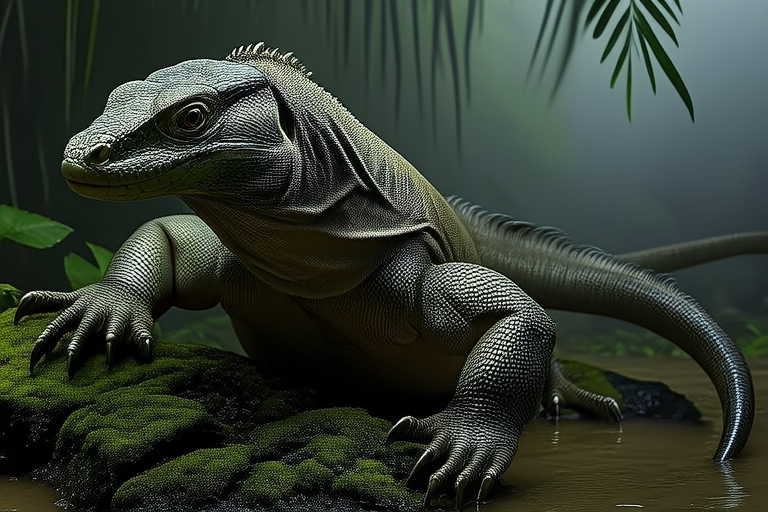From Jungle to Home: Everything You Need to Know About Owning a Water Monitor
Owning a water monitor can be a thrilling experience, but it comes with significant responsibilities. These large reptiles are native to tropical regions of Asia and require specialized care. This comprehensive guide will cover everything you need to know about owning a water monitor, from their natural habitat to housing needs and legal considerations.
The Natural Habitat of Water Monitors
Water monitors (Varanus salvator) are native to the tropical forests and wetlands of Southeast Asia, including countries like India, Sri Lanka, Indonesia, and Malaysia. They thrive in humid environments with access to both land and water. Their natural habitat includes dense jungles, mangrove swamps, and riverbanks where they can bask in the sun and hunt for food.
Understanding the water monitor’s natural habitat is crucial for recreating a suitable environment in captivity. While it’s impossible to replicate their wild environment exactly, providing ample space, humidity, and temperature gradients can help these reptiles thrive in your home.
Diet Requirements
Water monitors are carnivorous and require a balanced diet rich in proteins. In the wild, they feed on a variety of prey, including insects, fish, small mammals, birds, and even other reptiles. As pets, their diet should consist of appropriately sized rodents, feeder fish, and occasional insects.
It’s essential to offer a varied diet to ensure proper nutrition. Feeding your water monitor a mix of live and frozen-thawed prey items will help prevent nutritional deficiencies. Additionally, supplementation with calcium and vitamins is recommended to support bone health and overall well-being.
Housing Needs
Adequate housing is critical for the health and happiness of your water monitor. Given their size and activity level, a spacious enclosure is necessary. A minimum tank size of 6 feet long, 3 feet wide, and 4 feet tall is recommended for a juvenile water monitor. As they grow, the enclosure should be expanded accordingly.
The enclosure should have a secure lid or screen top to prevent escapes. It’s also important to provide a basking area with a heat lamp that maintains a temperature gradient between 85°F and 95°F (29°C to 35°C). A water area large enough for swimming is essential, as water monitors spend a considerable amount of time in the water.
Substrate options include reptile-safe wood chips, coconut fiber, or a mixture of both. Avoid using sand or gravel, as these can cause impaction if ingested. Regular cleaning and maintenance of the enclosure are necessary to ensure a healthy living environment.
Health Concerns
Water monitors are generally hardy animals, but they are susceptible to certain health issues if not properly cared for. Respiratory infections, metabolic bone disease, and parasites are common problems. Regular veterinary check-ups, especially by a reptile specialist, are recommended to catch any potential issues early.
Maintaining proper hygiene and providing a balanced diet can help prevent many health problems. Additionally, monitoring your water monitor’s weight and behavior can alert you to any changes that may indicate illness.
Behavioral Traits
Water monitors are intelligent and curious creatures, often displaying playful and interactive behaviors. However, they can also be territorial and aggressive, especially when provoked or threatened. Proper handling and socialization are key to building a positive relationship with your pet.
Consistent and gentle handling from a young age can help acclimate your water monitor to human interaction. However, always approach with caution and respect their boundaries. Providing mental stimulation through enrichment activities, such as puzzle feeders or hiding spots, can help keep your water monitor engaged and happy.
Legal Considerations for Ownership
Before bringing a water monitor into your home, it’s important to research and comply with local regulations regarding exotic pet ownership. Some areas may prohibit or heavily restrict the keeping of water monitors due to their size, potential threat to native wildlife, or conservation concerns.
Obtaining the necessary permits and licenses, if required, is crucial. Additionally, consider the ethical implications of keeping an exotic pet. Ensure that you are prepared for the long-term commitment and responsible ownership.
Tips for Creating a Safe and Enriching Environment at Home
Creating a safe and enriching environment for your water monitor involves careful planning and attention to detail. Start by ensuring that all enclosures and equipment are secure and escape-proof. Provide multiple hiding spots and climbing opportunities to encourage natural behaviors.
Incorporate enrichment activities that stimulate both physical and mental exercise. Puzzle feeders, floating logs, and water toys can keep your water monitor entertained and engaged. Regularly rotate these items to maintain interest and prevent boredom.
Lastly, be mindful of household safety. Keep electrical cords and toxic substances out of reach and ensure that any other pets or children are supervised around your water monitor. By taking these precautions, you can enjoy a rewarding and fulfilling relationship with your exotic pet.
Owning a water monitor is a unique and exciting endeavor that requires dedication and commitment. With proper care, a suitable environment, and regular veterinary check-ups, your water monitor can thrive in your home. Remember that these animals have complex needs and behaviors, so always prioritize their well-being and safety.
By understanding and addressing these aspects, you can ensure a harmonious and enriching life for both you and your water monitor. Happy petting!
